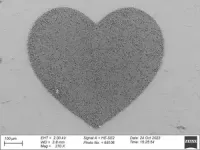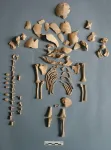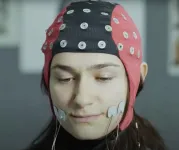(Press-News.org) A Rutgers professor who studies and improves the design of algorithms – human-made instructions computers follow to solve problems and perform computations – has been selected to receive a 2024 Sloan Research Fellowship.
Aaron Bernstein, an assistant professor in the Department of Computer Science in the School of Arts and Sciences at Rutgers University-New Brunswick, was named one of 126 researchers drawn from a select group of 53 institutions in the U.S. and Canada. The award honors extraordinary creativity, innovation and the potential to become a scientific leader in any of a wide range of fields – chemistry, computer science, Earth system science, economics, mathematics, neuroscience and physics.
“Dr. Bernstein is an outstanding researcher whose analyses promise to open new realms of knowledge that will benefit society,” Rutgers University–New Brunswick Chancellor Francine Conway said. “It is because of his work, and that of his colleagues, that Rutgers–New Brunswick is known for transformative scholarship that serves the common good.”
Bernstein said he has long loved math, majoring in the subject as an undergraduate at the Massachusetts Institute of Technology. Both of Bernstein’s Russian-born parents hold doctoral degrees in mathematics as well as his sister.
“Some ridiculously large portion of my family started out in math,” he said. “So I just kind of followed in my family’s footsteps.”
While still in college, Bernstein started to pay attention to theoretical computer science, which he describes as being “in between math and computer science.” Tied to the invention of computers, theoretical computer science is a far younger field than math, with a history that stretches back to antiquity, he said. This aspect appealed to him because there is a smaller body of knowledge to be absorbed in a newer field, which potentially allows for a faster route to making new contributions.
Bernstein said he was surprised to be chosen for the academic honor.
“Sloan selects people from such a broad spectrum, from so many areas of science – and I work in a somewhat niche area of computer science that isn’t as well known,” said Bernstein, adding he is happy the foundation honored the area he studies within theoretical computer science known as graph algorithms. “I’m excited.”
Winners receive a two-year, $75,000 fellowship which can be used flexibly to advance the Fellow’s research.
A Sloan Research Fellowship is one of the most prestigious awards available to early-career researchers as many fellows have gone on to become distinguished figures in science. Renowned physicist Richard Feynman was a Sloan Fellow, as was mathematician John Nash, one of the fathers of modern game theory. Some 57 Fellows have received a Nobel Prize, including Moungi Bawendi, last year’s recipient of the Nobel Prize in Chemistry.
As a doctoral student at Columbia University and then as a postdoctoral associate at Technische Universität Berlin, Bernstein gravitated toward graph algorithms as his principal research interest. In computer science, graphs are mathematical structures that represent a set of objects, called vertices or nodes. The connections between them are known as edges. Graph algorithms are computational procedures used to solve various problems related to graphs.
While theorists such as Bernstein study structures that are highly abstract, the knowledge gained from such work has real-world applications. “You can zoom out from any one particular domain of study and consider problems that are shared by many disparate areas,” he said.
Bernstein solves problems related to graphs by devising new algorithms which, step by step, produce the shortest path between two points on the graph. Work that attacks these computational bottlenecks, he said, are broadly applied in industry.
Graph algorithms are widely used in the design of computer networks, air and mass transit routes and social networks. Insights such as Bernstein’s, he said, could ultimately help engineers design the optimal sequence of motions needed for a robot to navigate a set of obstacles, or aid chemists in finding which sequence of chemical reactions is the most energy-efficient process by which to make a product.
In a 2022 study conducted by Bernstein and two colleagues, the team solved an important long-standing problem: devising an algorithm to find the shortest, fastest route through a network, even when some steps cancel out others. The manuscript describing the solution was presented at the IEEE Symposium on Foundations of Computer Science 2022, sponsored by the Institute of Electrical and Electronics Engineers, and received a Best Paper Award.
“You’re always asking, for any task, ‘How do I do this using as few basic operations as possible?” Bernstein said. “Even though it’s in this abstract world, it is still about computation.”
Bernstein said he plans to use the fellowship to fund the work of a postdoctoral associate on a new project.
END
Rutgers professor of computer science is named Sloan Fellow
Fellowship is among the most prestigious in science for early-career researchers
2024-02-20
ELSE PRESS RELEASES FROM THIS DATE:
Challenge Announcement: Global Initiative to Digitalize Scents by the Digital Olfaction Society Revolutionary Scent Digitalization Challenge 2025: Capturing Aromas to Reproduce Anywhere
2024-02-20
Tokyo, The Digital Olfaction Society (DOS) announces a global initiative for 2025, aiming to digitize and transmit scents from various locations around the world for reproduction in Tokyo. This project intends to capture a wide range of fragrances representing the cultural diversity of the globe, leading to a significant development in Tokyo.
Invitation for Worldwide Participation
DOS invites teams from around the world to participate in this initiative. Whether located in major cities such as Berlin, New York, Dubai, or any place with a distinctive aroma, contributions ...
VUB researchers assemble patterns of micro- and nanoparticles
2024-02-20
Researchers from the Department of Chemical Engineering at the Vrije Universiteit Brussel, Riga Technical University and the MESA+ Institute at the University of Twente have succeeded in arranging very small particles (10 µm to 500 nm, 10 to 100 times thinner than a human hair) in a thin layer without using solvents. This is a hugely important first step towards developing a new generation of sensors and electronics for a wide range of applications.
“Common methods based on crystallising solutions are ...
Ancient DNA reveals Down syndrome in past human societies
2024-02-20
By analysing ancient DNA, an international team of researchers have uncovered cases of chromosomal disorders, including what could be the first case of Edwards syndrome ever identified from prehistoric remains.
The team identified six cases of Down syndrome and one case of Edwards syndrome in human populations that were living in Spain, Bulgaria, Finland, and Greece from as long ago as 4,500 years before today.
The research indicated that these individuals were buried with care, and often with special grave goods, showing that they were appreciated as members of their ancient societies.
The global collaborative study, led by first author Dr ...
Smiling is the secret to seeing happiness, new research reveals
2024-02-20
Smiling for just a split second makes people more likely to see happiness in expressionless faces, new University of Essex research has revealed.
The study led by Dr Sebastian Korb, from the Department of Psychology, shows that even a brief weak grin makes faces appear more joyful.
The pioneering experiment used electrical stimulation to spark smiles and was inspired by photographs made famous by Charles Darwin.
A painless current manipulated muscles momentarily into action – ...
Antil studying efficient algorithms for optimization problems with PDE constraints
2024-02-20
Harbir Antil, Professor, Mathematical Sciences; Director, Center for Mathematics and Artificial Intelligence (CMAI), received funding for the project: “Efficient Algorithms for Optimization Problems with PDE Constraints.”
Antil and his collaborators are examining generic optimization problems constrained by partial differential equations (PDEs) with or without uncertainty. In case of uncertainty, a risk-averse optimization framework will be developed. Decomposition and Compression techniques will be utilized to overcome the high computational costs. Several applications in various disciplines such ...
Age-related changes in fibroblast cells promote pancreatic cancer growth and spread
2024-02-20
Older people may be at greater risk of developing pancreatic cancer and have poorer prognoses because of age-related changes in cells in the pancreas called fibroblasts, according to research led by investigators from the Johns Hopkins Kimmel Cancer Center, the Johns Hopkins Bloomberg School of Public Health and the Bloomberg~Kimmel Institute for Cancer Immunotherapy.
The study, published online Feb. 8 in Cancer Research, provides clues as to why pancreatic cancer is more common and aggressive in older people. It may also help scientists develop ...
University of Birmingham signs pioneering collaboration agreement with Vital Energi
2024-02-20
The University of Birmingham has signed a collaboration agreement with Vital Energi to develop and commercialise a range of innovative thermal storage solutions, which will help accelerate decarbonisation within the heating and cooling sector.
The University and Vital Energi will work together over an initial four years to continue the development of thermal storage Intellectual Property (IP) with a view to bringing a number of products to market. As part of the agreement, the University has assigned several IP rights, including a number of patents, to Vital Energi.
The implementation of thermal energy storage is imperative to address the challenges posed ...
Oocytes outsmart toxic proteins to preserve long-term female fertility
2024-02-20
Oocytes are immature egg cells that develop in almost all female mammals before birth. The propagation of future generations depends on this finite reserve of cells surviving for many years without incurring damage. In mice, this can be a period of up to eighteen months, while in humans it can last almost half a century, the average time between birth and menopause. How the cells accomplish this remarkable feat of longevity has been a longstanding question.
Researchers at the Centre for Genomic ...
The Radcliffe Wave is waving
2024-02-20
A few years ago, astronomers uncovered one of the Milky Way’s greatest secrets: an enormous, wave-shaped chain of gaseous clouds in our sun’s backyard, giving birth to clusters of stars along the spiral arm of the galaxy we call home.
Naming this astonishing new structure the Radcliffe Wave, in honor of the Harvard Radcliffe Institute, where the undulation was originally discovered, the team now reports in Nature that the Radcliffe Wave not only looks like a wave, but also moves like one – oscillating through space-time much like “the wave” moving through a stadium full of fans.
Ralf Konietzka, the paper’s ...
Examining excess mortality associated with the pandemic for renters threatened with eviction
2024-02-20
About The Study: Housing instability, as measured by eviction filings, was associated with a significantly increased risk of death over the first 20 months of the COVID-19 pandemic in this study that included 282,000 renters who received an eviction filing. Eviction prevention efforts may have reduced excess mortality for renters during this period.
Authors: Nick Graetz, Ph.D., of Princeton University in Princeton, New Jersey, is the corresponding author.
To access the embargoed study: Visit ...
LAST 30 PRESS RELEASES:
Why nail-biting, procrastination and other self-sabotaging behaviors are rooted in survival instincts
Regional variations in mechanical properties of porcine leptomeninges
Artificial empathy in therapy and healthcare: advancements in interpersonal interaction technologies
Why some brains switch gears more efficiently than others
UVA’s Jundong Li wins ICDM’S 2025 Tao Li Award for data mining, machine learning
UVA’s low-power, high-performance computer power player Mircea Stan earns National Academy of Inventors fellowship
Not playing by the rules: USU researcher explores filamentous algae dynamics in rivers
Do our body clocks influence our risk of dementia?
Anthropologists offer new evidence of bipedalism in long-debated fossil discovery
Safer receipt paper from wood
Dosage-sensitive genes suggest no whole-genome duplications in ancestral angiosperm
First ancient human herpesvirus genomes document their deep history with humans
Why Some Bacteria Survive Antibiotics and How to Stop Them - New study reveals that bacteria can survive antibiotic treatment through two fundamentally different “shutdown modes”
UCLA study links scar healing to dangerous placenta condition
CHANGE-seq-BE finds off-target changes in the genome from base editors
The Journal of Nuclear Medicine Ahead-of-Print Tip Sheet: January 2, 2026
Delayed or absent first dose of measles, mumps, and rubella vaccination
Trends in US preterm birth rates by household income and race and ethnicity
Study identifies potential biomarker linked to progression and brain inflammation in multiple sclerosis
Many mothers in Norway do not show up for postnatal check-ups
Researchers want to find out why quick clay is so unstable
Superradiant spins show teamwork at the quantum scale
Cleveland Clinic Research links tumor bacteria to immunotherapy resistance in head and neck cancer
First Editorial of 2026: Resisting AI slop
Joint ground- and space-based observations reveal Saturn-mass rogue planet
Inheritable genetic variant offers protection against blood cancer risk and progression
Pigs settled Pacific islands alongside early human voyagers
A Coral reef’s daily pulse reshapes microbes in surrounding waters
EAST Tokamak experiments exceed plasma density limit, offering new approach to fusion ignition
Groundbreaking discovery reveals Africa’s oldest cremation pyre and complex ritual practices
[Press-News.org] Rutgers professor of computer science is named Sloan FellowFellowship is among the most prestigious in science for early-career researchers








